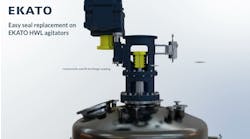Lack of an effective strategy and methodology for removing deficiencies in operating practices prevents most plants from achieving “world class performance.” At the many American plants that operate in reactive mode, defects and errors from poor practices typically represent more than 45% of all manufacturing problems while design and maintenance make up 50%. Overall Plant Effectiveness calculations indicate that if just 50% of the operating defects are removed, it is possible to increase capacity or reduce operating cost by around 9%.
A simple and practical approach to remove such deficiencies centers on improving “operational discipline.” This shouldn’t be confused with what is now commonly referred to as the achievement of “operational excellence” using advanced computerized control. They are, however, complementary.
A generally accepted concept is that every phase of an operation contains defects and that these defects are continually created during routine operation. However, many companies don’t confront the corollary — that only by simultaneously solving and removing the defects in all phases of the operation (including systems and people) at a faster rate than they are created will overall efficiency be improved.
The methodology
“Operational inaccuracy” has much in common with lapses in safety performance. Both are driven by two primary factors — working conditions and, much more importantly, peoples’ behavior. So, for both problems, it is essential to give the individuals involved a set of model behaviors and immediate, accurate and positive feedback when either a mistake is made or an unnecessary risk is taken.
Errors can be made while a process plant operates stably, due to lapses in concentration — during “extended uneventful vigilance.” However, the potential for miscues is much higher during transient conditions at upsets, emergency shutdown or startup. The transient conditions are far more critical and should get attention first.
Service conditions during upsets frequently move well outside the normal operating envelope, often involving numerous unnecessary repairs and adjustments until things return to normal. While the safety risks of such changes generally are well managed, this is not always true for actions affecting the integrity of the equipment and when non-fatal damage occurs.
It is important to prepare for unplanned (crash) shutdowns such as those due to a sudden utility or raw-materials interruption. A well-rehearsed response should be worked out for each type of predictable spike and should include individually assigned checklists for required actions. Comprehensive training and routine drills are essential.
Detecting deficiencies
It is crucial to encourage everyone on the operating team to recognize and report both potential and actual deficiencies and deviations in order that patterns of weakness can be addressed. These include behaviors such as:
• not following a procedure’s sequence or erring because of poorly defined procedures;
• adding or eliminating an operating step;
• using an incorrect equipment startup or shutdown procedure;
• making mistakes because of poor labeling of equipment and illegibility of gauges;
• operating outside prescribed limits, e.g., for temperature or flow;
• being slow to locate a blockage, flow restriction, etc.;
• not reporting and fixing loops that are in manual mode, cycling or operating within 5% of their maximum;
• needing to repeatedly cancel alarms; and
• not spotting defective equipment despite noise, leakage, vibration, etc.
Dealing with such issues requires establishing formal processes and an improvement team of plant people.
Pre-implementation steps
Form an implementation team consisting of a facilitator/leader, an operator from each shift who has some coaching ability, plus one or two engineers or managers. Keep the following pointers in mind as you set up the team:
Anticipate — and work from the onset — to address a possible “recrimination” mindset among staff. It is crucial to keep people from feeling ambushed when a problem arises and is discussed. So, for instance, make sure observational data are kept confidential and cannot be used for any punitive purpose.
Broad participation and employee empowerment must be integral parts of this “Kiezen” like program. One helpful step is to have each shift team responsible for rewriting a part of some operating procedures. (In football parlance, they should be trying to create the perfect playbook.) If any particular team has a problem with concepts or requirements that others agree to, it needs counseling early in the program. Once the procedures are updated, the focus then turns to perfect execution of them.
The implementation team needs direct access to management without going through the “lines of authority,” because it is not unusual to find that first-line supervisors are last to grasp the concepts or accept the change.
Explain the significance of the connections between the Operational Deviation Triangle, the Reliability Defect Triangle, the Quality Deviation Triangle and the Safety Severity Triangle. For example, most people are familiar with the concept that if the base of the Safety Severity Triangle is reduced (unsafe behaviors and near misses), then the total number and severity of accidents are cut. Similarly if the number of potential and actual operating deficiencies are decreased, the size of the Operational Deviation Triangle base and the overall number and severity of damaging operating incidents will go down.
Implementation
As already emphasized, a non-punitive atmosphere is crucial. Provide 50 or more carrots to one stick. Initially, focus on two areas:
1. Procedures improvement. Although not absolutely essential, consider creating a set of procedures written by average operators (with the oversight of engineers) for inexperienced or below-average operators. These procedures must be simple and pictorial and designed for easy and frequent reference (Figure 1). It’s a good idea to use a professional technical writer to put them into final, polished form. Revising and creating the procedures actually is in itself a very effective form of training.
Separate the procedures by operating phase into normal startup, normal shutdown, emergency shutdown (divided by type) and startup after emergency shutdown, etc. Refer to the OSHA process safety management format.
Add symbols (decals) to highlight critical operating steps, note whether they are critical because of safety, quality or production volume, and indicate consequences with “if/then” statements. Use pictures, diagrams and charts to replace words wherever possible.
Create individually assigned checklists for each operator for every phase.
2. The improvement management system. Record and investigate each incident, near miss or potential violation of a method or setpoint. Some plants use their existing Quality Defect Record – Nonconforming Material forms rather than add a new piece of paper. Reward the shift or team creating the greatest number of observations; this must be the ultimate “no blame/no shame game.”
Have someone competent in data analysis conduct a monthly systematic review and classification of the results so that corrective actions, such as training or retraining, programming or instrumentation redesign, are directed at the core issues. Look for latent system and human factors. (Group and prioritize issues after three months.)
Feedback should be soon/certain/positive rather than late/uncertain/negative, which usually is the case. Have operators with good coaching skills help other operators and make sure that this strategy is understood. Rotate the role of observer. Be careful to control any feedback until the team is comfortable with the process.
Post-implementation steps
Look for and remove organizational structures, rules, etc., that encourage blame and punitive actions. Whatever measures are necessary should target the very few habitual and repeat offenders, not the average worker trying to do a good job. Prevention is the best cure for the recrimination problem.
Schedule regular reinforcement meetings or training sessions. Give supervisors regular feedback to help them monitor their progress toward the new way of dealing with issues.
Recognize and celebrate the accomplishment of each of the steps by providing free lunches or by providing small gifts such as tee-shirts, etc. Behavior is the hardest thing to change, so set realistic timelines (multiple quarters or years rather than days or months) for accomplishing the change.
Involve as many employees as possible in working toward a solution. The “group sweat” generated eventually acts like glue. Involvement creates buy-in and will help to solve the problem faster and give the process added support once the problem is solved.
Use leading indicators to provide weekly feedback of individual and team behavior which, if repeated, will lead to sustained improvement. Being able to make the connection is essential for the program to succeed.
Identifying a deficiency or potential defect, finding and removing its cause, and taking some action to prevent recurrence must become a routine part of the job.
Leading indicator dashboards
A monthly point system can play a key role in success by providing immediate feedback.
We suggest awarding points for each shift team, on a basis such as the following (which should be tailored for each unit):
- one for every record of a deviation, near deviation or potential deviation submitted (the more deviations reported, the better);
- two for each percent of the plant for which a Simplified, Pictorial Tabloid Procedure (SPTP) was written (it might take two years to complete the task);
- three for each individually assigned checklist observed in routine use; and
- 20 for successfully implementing an action in response to a defect or deviation found.
Deduct points for the following:
- two for every loop observed not in automatic mode;
- five for each deficiency that resulted in a minor incident;
- 10 for each deficiency that led to a major incident involving a shutdown; and
- 10 for any unreported incident.
The payoff
Regardless of how well your plant now runs, mounting a major effort to improve its operational accuracy can provide substantial benefits. Many of the most-efficient plants now operating in a proactive mode, after having removed all of their major deficiencies in maintenance practices, work planning and scheduling, engineering and design, eventually conclude that improved operational accuracy is the remaining obstacle to their achieving world-class operating performance.
Bernie Price is CEO of Polaris Veritas Inc., a Houston-based consulting group. E-mail him at [email protected].

